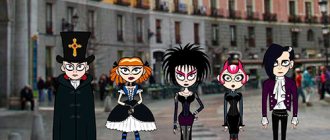Today, there are many different subcultures in world society. Representatives of a particular subculture are called informals - they are distinguished by their originality, unusualness, and brightness. An informal person tries to demonstrate his individuality. We present a list of the main subcultures, and then we will talk about some of them in more detail.
- Alternatives
- Anime people
- Bikers
- Vanillas
- Glamor
- Gopniks
- Goths
- Grangers
- Graffitiers
- Cyber Goths
- Metalheads
- New Age
- Punks
- Fedots
- Rastafarians
- Ravers
- Rockers
- Rappers
- Skinheads
- Hipsters
- Straight-age
- Tolkienists
- Trash Models
- Freaks
- Football fans
- Hackers
- Hippie
- Hipsters
- Emo
Alternatives
In the early 90s, an alternative subculture emerged, which included rappers, metalheads and punks. Representatives of this subculture are distinguished by their friendliness towards representatives of other directions. It is believed that the subculture was formed thanks to the group Rage Against The Machine.
The appearance of alternative artists is catchy; they are quite easy to distinguish from representatives of other subcultures. As a rule, they wear piercings and loose clothes. Representatives of this subculture do not have any special ideology.
Relationships between different subcultures
Subculture is a very common phenomenon, divided into types, each of which has its own characteristics and differences. Like other cultural phenomena, subcultures were formed in a culturally saturated environment. This happened at the beginning of the twentieth century, during a period of oversaturation of society with various ideas and philosophical movements. In the modern world, it is impossible to say that subcultures are autonomous and in no way connected with others. They have to interact, and conflicts often arise in their relationships.
Some subcultures openly declare hostility to each other's worldview. This is called subcultural antagonism. We can talk about musical subcultures and, accordingly, conflicts arise as a result of differences in preferences. The situation became especially noticeable when many musical styles, significantly different in sound and style, began to become popular in society. Each subculture believes that their genre is better and has depth, unlike others.
The tension that arises between the parties can lead to confrontation between the participants. Each subculture tries to honor its own unspoken rules. Often they are not even prescribed, but appear intuitively. In similar situations, representatives of different subcultures can act completely opposite, depending on their worldview and motivation. Any association adheres to its own value system, and, naturally, considers the opinions of other informal groups not entirely correct or completely absurd. In the event of a clash in such a situation, it is difficult to reach an agreement. For example, skinheads do not consider it shameful to seek their own righteousness by going through physical violence. At the same time, emos are not at all prone to violence and can even sacrifice their lives to prove the truth of their own beliefs.
The main task of society is to recognize that a subculture is part of the general culture. It is not at all necessary to use the usual radical measures, trying to prove the significance of your opinion and your own rightness. Many parents worry about their children becoming part of a subculture, but when it comes to something as innocuous as clothing styles, allow your teen to express their individuality. Many young people are trying to express their protest by joining one group or another - show them that you are on the same side with them and there is no need to oppose each other.
Bikers
The biker subculture originated around the 60s and 70s. Representatives of the movement - bearded, long-haired men - cannot imagine their life without a motorcycle, beer and rock music. These attributes are the hallmarks of bikers.
As a rule, they ride in groups and each of the bikers belongs to a club. The stripes on his clothes determine which club he is a member of. This is a distinctive sign that makes bikers different from each other.
The biker subculture adheres to its own value system, which is strikingly different from the generally accepted norms of a “civilized society.”
Afterword
Not all young people from subcultures manage to socialize successfully.
- For some, the subculture becomes just a stage of entertainment, an assistant in finding themselves and their place in society.
- For some, it is a stage before the onset of criminal or addictive behavior. For example, a passion for the Rastafarian culture can result in both successful socialization and the use of hard drugs, i.e., drug addiction. Activists of the pink rock movement can become representatives of gay movements, and goths can “grow” into Satanists.
- In addition to the two mentioned above, there is a third scenario for the development of events for the informal – permanent life within the subculture (“eternal informals”). These people are not taken seriously either by society or by representatives of their own subcultures. As a result, such people do not live, but exist within a very narrow framework, prescribed by them, and in an independently created illusory world.
The energy of youth needs to be channeled in the right direction. It rarely happens that it is impossible to redirect a young person from a destructive and antisocial subculture to a prosocial one. Most often, he just wants to get carried away with something, to be involved, and does not adhere to specific deep-rooted beliefs. Therefore, it is only necessary for him to present an alternative to his subculture in an interesting and competent way from the side of psychological and pedagogical science.
It is necessary not to fight subcultures, but to accept them and communicate in their own language, help in organizing leisure time, and take an interest in their lives. Focus on the benefits of subcultures (development of youth abilities, support in socialization, progress of society). Promote the development of prosocial creative groups.
Gopniks
The Gopnik subculture began to exist in the last years before the collapse of the USSR. The ideology and behavior of representatives of this trend are similar to the behavior of hooligans. A distinctive feature of Gopniks is a penchant for violence, a low level of intelligence and prison slang, which in terms of difficulty of understanding can sometimes be compared with the complex languages of the world.
Gopniks, as a rule, like to listen to music in the style of prison chanson. They are often aggressive towards other subcultures. In particular, movements such as emo, goths, rappers, and gopniks are not recognized and conflict with their representatives.
Gopniks have short hair and wear tracksuits. These are the main distinguishing features of adherents of this subculture.
Types of subcultures
The list of subcultures has several types:
According to musical preferences
Representatives of individual subcultures often prefer different music. Goths like gothic metal, metallists like heavy metal and its types, punks like punk rock, rastafarians like reggae, emo likes post-hardcore and so on.
Sports subcultures
One of the most famous sports subcultures is parkour. The term denotes the masterly art of moving and avoiding obstacles in space. The key idea of parkour: “there are no boundaries, there are only obstacles.” Parkour became especially popular after the release of the films “The Thirteenth District” and “Yamakashi”.
Football fans are also considered a special sports subculture. They became a more organized group at the turn of the 70-80s of the twentieth century.
By style
Among the subcultures that stand out in style are usually noted: Visual kei, military, teddy boys, cyber goths, mods, dudes, freaks. All of them have their own distinctive features in the image.
According to public beliefs
The list of subcultures also includes those that stand out based on their social beliefs: beatniks, SHARP skinheads, RASH skinheads, straight edgers, anarcho-punks, yuppies, informals, new age, happy people.
By hobby
People who are united by a common specific hobby and accompanying paraphernalia also consider themselves to be one of the subcultures. We can talk about the following communities: bikers, reenactors, gamers, b-boys, role-players, and so on.
By hooligan behavior
The greatest fears among ordinary citizens are representatives of precisely these subcultures, similar in their hooligan and defiant behavior: ultras, highly organized lyubers, ore boys, football brawlers, and gopniks.
According to other signs
There are many youth subcultures united by other hobbies. Among them are otaku - people who adore and are well versed in anime and various manga. Also quite remarkable are furries who are fans of anthropomorphic creatures and consider themselves part of the furry fandom.
Metalheads
The metal subculture originated in the 1960s and spread almost throughout the world. The impetus for the emergence of the subculture was music in the style of Heavy Metal. Metalheads, as a rule, are fans of heavy rock music and all types of metal.
The image of a representative of the subculture includes leather clothing, images of skulls, a lot of metal jewelry on the body (chains, spikes, bracelets, etc.), heavy boots, ear piercings, and bandanas. They have no ideology or philosophy as such; all beliefs and views are focused entirely on music.
Roleplayers are inhabitants of two worlds
Role-players or historical reenactors are another direction of the art subculture.
The role-playing movement is based on a passion for fantasy or history. Each participant in the role-playing game transforms into a specific character and acts according to the script. The game can be based on both historical events and plots of works in the fantasy style.
Participants try to replicate living conditions, costumes, crafts, and battles of a particular era as faithfully as possible. Vikings, Ancient Rus' or medieval knightly battles are popular among roleplayers.
A separate direction of the role-playing movement are Tolkienists - fans of J.R. Tolkien. Participants in this subculture transform into characters from his books: elves, orcs, gnomes, hobbits, acting out scenes from the universe invented by the writer.
In ordinary life, participants in the role-playing movement may not stand out from the crowd, but many prefer unusual jewelry and clothes that are stylistically close to the character’s costumes; many create accounts on social networks on behalf of their hero.
Role-playing games are a form of escapism, a way to escape reality. For some it is a break from the daily routine, for others it is an alternative and more preferable reality. Among role-players you can meet both teenagers and older people.
Hipsters
The subculture of dudes was formed in the second half of the 40s - 50s. At this time, young people dressed in provocative clothes appeared on the streets of cities. Representatives of the movement were distinguished by cynicism in their judgments and indifference to Soviet norms of behavior.
The hipsters of those times protested against standard stereotypes of behavior and monotony in clothing. The subculture undoubtedly left a bright imprint on the Soviet era.
Men-dandies wore tight trousers (“pipes”), long double-breasted jackets, bright shirts combined with colorful ties, pointed boots and dark glasses.
The girls decorated their clothes with sewn bows and a lot of jewelry. Hipsters, as a rule, were the children of high-ranking officials or professors.
Youth subcultures and their role in modern society
Time flies quickly and the world adapts to its changes. However, there have always been those who considered it necessary to adhere to their chosen ideology, challenging the majority of those around them. In the twentieth century, such individuals united under the term “subcultures” and actively continue to develop their communities.
Initially, representatives of such groups opposed themselves to the majority in every possible way and were reluctant to accept newcomers into their ranks. Now there is much more freedom in this regard. In the Soviet Union they were called an informal youth association. They were viewed with disapproval and fear, but now subcultures no longer seem unusual, scary or unhealthy.
They are no longer considered something categorically negative, and even bring some benefit to society. Now people who previously kept to themselves, afraid of being misunderstood, can easily find friends with similar interests, no matter what crazy hobbies interest them.
Members of various subcultures are often teenagers who want to protest to adults, and if their choice falls on gopniks and emo, this can lead to problems.
Freaks
The freak subculture formed in the 20th century in North America. Representatives of the movement adhere to the main idea - to stand out among the crowd of surrounding people. For these purposes, not only clothing is used, but also behavior and philosophy. The term “freak” comes from the English word Freak, which means strange person. Each follower of the subculture strives to create his own unique image.
Freaks are ardent supporters of piercing - they pierce themselves en masse in all sorts of places, and also cover their bodies with tattoos with images, inscriptions and patterns.
How did the term come about?
The term “subculture” is derived from the Latin words sub (under) and cultura (culture). Therefore, in the Russian language the word “subculture” can be used on an equal basis with it. This term is used in political science, sociology, philosophy, anthropology and many other sciences, in which it can be interpreted somewhat differently. It is important not to confuse subcultures with youth communities consisting of young people with common interests.
This concept was introduced by the American sociologist David Riesman. He gave it the following definition: a subculture is a certain social group that demonstratively chooses moral values, an appearance style and manners that do not correspond to the generally accepted ones. This phenomenon was later studied by British sociologist Dick Habdige. He noted that subcultures include people united by common tastes and at the same time dissatisfied with the norms accepted in their society.
Interestingly, in the 20th century, many authors used alternative terms to refer to this phenomenon. Thus, the French sociologist Michel Maffesoli calls youth subcultures “urban tribes,” and the Soviet biologist Viktor Dolnik uses the term “clubs.” In the USSR, the concept of “informal youth associations” was widely used, and their representatives were called “informals.” Around the same time, the slang word “tusovka,” which is still popular today, appeared.











